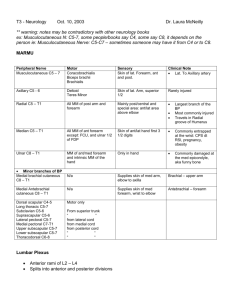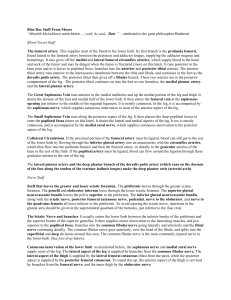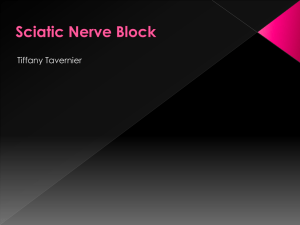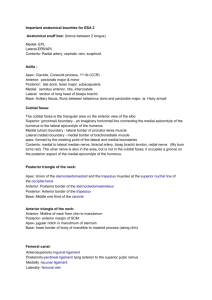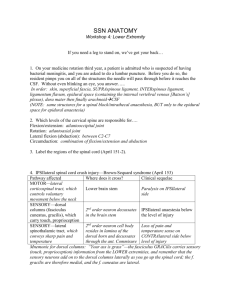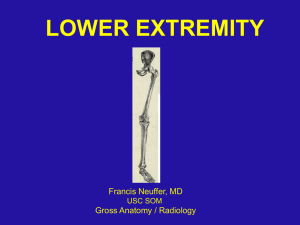LOWER LIMB MCQs - ANSWERED 1. The following nerve supplies
advertisement
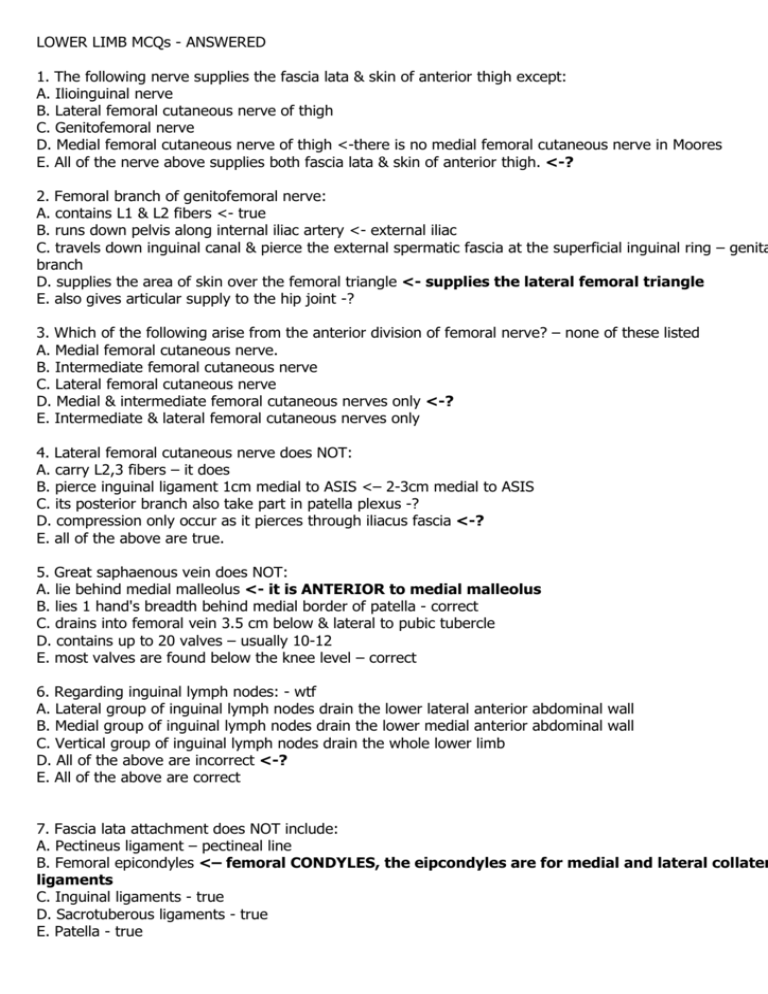
LOWER LIMB MCQs - ANSWERED 1. The following nerve supplies the fascia lata & skin of anterior thigh except: A. Ilioinguinal nerve B. Lateral femoral cutaneous nerve of thigh C. Genitofemoral nerve D. Medial femoral cutaneous nerve of thigh <-there is no medial femoral cutaneous nerve in Moores E. All of the nerve above supplies both fascia lata & skin of anterior thigh. <-? 2. Femoral branch of genitofemoral nerve: A. contains L1 & L2 fibers <- true B. runs down pelvis along internal iliac artery <- external iliac C. travels down inguinal canal & pierce the external spermatic fascia at the superficial inguinal ring – genita branch D. supplies the area of skin over the femoral triangle <- supplies the lateral femoral triangle E. also gives articular supply to the hip joint -? 3. Which of the following arise from the anterior division of femoral nerve? – none of these listed A. Medial femoral cutaneous nerve. B. Intermediate femoral cutaneous nerve C. Lateral femoral cutaneous nerve D. Medial & intermediate femoral cutaneous nerves only <-? E. Intermediate & lateral femoral cutaneous nerves only 4. Lateral femoral cutaneous nerve does NOT: A. carry L2,3 fibers – it does B. pierce inguinal ligament 1cm medial to ASIS <– 2-3cm medial to ASIS C. its posterior branch also take part in patella plexus -? D. compression only occur as it pierces through iliacus fascia <-? E. all of the above are true. 5. Great saphaenous vein does NOT: A. lie behind medial malleolus <- it is ANTERIOR to medial malleolus B. lies 1 hand's breadth behind medial border of patella - correct C. drains into femoral vein 3.5 cm below & lateral to pubic tubercle D. contains up to 20 valves – usually 10-12 E. most valves are found below the knee level – correct 6. Regarding inguinal lymph nodes: - wtf A. Lateral group of inguinal lymph nodes drain the lower lateral anterior abdominal wall B. Medial group of inguinal lymph nodes drain the lower medial anterior abdominal wall C. Vertical group of inguinal lymph nodes drain the whole lower limb D. All of the above are incorrect <-? E. All of the above are correct 7. Fascia lata attachment does NOT include: A. Pectineus ligament – pectineal line B. Femoral epicondyles <– femoral CONDYLES, the eipcondyles are for medial and lateral collater ligaments C. Inguinal ligaments - true D. Sacrotuberous ligaments - true E. Patella - true 8. Fascia lata does NOT A. meet Scarpa's fascia at the inguinal ligament <- it is a fingers breadthe inferior… B. is continuous with the iliotibial tract - true C. is continuous with the deep fascia of the calf posteriorly - true D. splits to enclose tensor fascia latae & adductor magnus – ? should it read glut max, add mag is deep E. All of the above 9. Iliotibial tract: A. arises at the level of lesser trochanter at the insertion of tensor fasciae latae & gluteus maximus – arises from iliac tubercle B. attaches to both tibial epicondyles – to the anterolateral turbercle of tibia (Gerdy tubercle) C. acts to keep the knee in hyperextension & stabilizes the pelvis in walking <- correct D. can assist extension of the fully flexed knee – b/c attached to femur via lat intermuscular septum cannot move the knee E. attaches to medial intermuscular septum of the thigh – to the lateral intermuscluar septum 10. Boundaries of femoral triangle does NOT include: A. inguinal ligament B. medial border of sartorius C. lateral border of adductor longus <- should be medial border, but Moore’s lists it as lateral… D. All of the above E. None of the above 11. Floor of the femoral triangle EXCLUDES: A. adductor brevis - briefly visable between pectineus and adductor longus B. pectineus - yes C. iliacus - yes D. psoas major - part of iliopoas E. psoas minor <- from T12 – L1 to iliopectineal arch, above inguinal ligament 12. Intermediate femoral cutaneous nerve pierces: - wtf A. Rectus femoris B. Pectineus C. Adductor longus D. Sartorius <-? Not listed in Moore’s E. None of the above, this nerve does not pierce muscle. 13. Psoas major: A. femoral artery lies on it <- correct, in the femoral triangle B. inserts into greater trochanter - lesser trochanter C. its only action is to flex hip - it stabilizes also D. supplied by anterior division of femoral nerve - supplied by anterior rami of L1,2,3. iliacus is by femoral n E. all of the above 14. Pectineus muscle does NOT A. lie anterior to anterior division of oburator nerve – it does, the anterior division of obturator is on the ant surface of abductor brevis posterior to pectineus B. lies posterior to femoral vein & femoral canal – its anterior surface is the floor C. acts to flex & laterally rotate hip <– it flexes, adducts and medially rotates the hip D. supplied by anterior division of femoral nerve – it is and may receive a branch from obturator E. inserts into an area below lesser trochanter – the pectineal line, inferior to lesser trochanter 15. Femoral sheath does NOT contain A. Femoral canal B. Femoral nerve <– lateral and outside the sheath C. Femoral artery D. Femoral vein E. Femoral nerve & vein ??? 16. Femoral artery: A. enters thigh at the midpoint of inguinal ligament – this is correct! B. is separated from the head of femur by psoas major <– also correct? C. gives supply to all thigh muscle directly – obturator helps supply adductors (and posterior branch -> acetabular branch -> NOF) D. All of the above E. None of the above 17. Profunda femoris artery: A. arises from the lateral side of femoral artery 4 cm below inguinal ligament B. lies between adductor longus & magnus C. ends as a perforating artery traveling beneath adductor brevis D. its branch takes part in the trochanteric & cruciate anastomosis E. All of the above are true <18. Femoral vein: A. its tributaries mirrors that of femoral artery in the femoral triangle – great saphenous has no arterial mirror B. lies lateral to the femoral artery - medial C. has valves just above the entry for profunda femoris vein <- not listed, but ok D. profunda femoris vein enters femoral vein at the saphenous opening <- the saphenous does, the deep vein of thigh joins at the inferior end of femoral triangle 8cm below inguinal ligament, and 5cm below saphenous E. All of the above 19. Branches of the femoral nerve is divided into anterior & posterior divisions by: A. medial circumflex femoral artery B. lateral circumflex femoral artery <- not listed in Moore’s C. profunda femoris artery D. adductor brevis - obturator E. sartorius 20. Branches of the anterior division of femoral nerve does NOT include: A. medial femoral cutaneous nerve B. intermediate femoral cutaneous nerve C. lateral femoral cutaneous nerve <- arises from lumbar plexus L2-3 D. nerve to sartorius E. nerve to pectineus 21. Which of the following branches of deep division of femoral nerve gives supply to the hip joint? A. nerve to rectus femoris <- not listed in Moore’s B. nerve to vastus medialis C. nerve to vastus intermedius D. nerve to vastus lateralis E. saphenous nerve 22. Which part of quadriceps femoris has attachment to the hip bone? – define hip bone = pelvis A. rectus femoris <- from AIIS, crosses 2 joints B. vastus medialis – linea aspera C. vastus intermedius – shaft of femur D. vastus lateralis – linea aspera E. none arise from the hip bone 23. Which part of quadriceps femoris has direct attachment to the patella? A. rectus femoris B. vastus medialis <- forms medial patella retinacula C. vastus intermedius D. vastus lateralis <- ?forms lateral patella retinacula E. none of them attaches directly to the patella 24. Patellar retinacula is: A. also called patella ligament – no, the patella ligament is extension of the quadraceps tendon to the tibial tuberosity B. the lower horizontal fibers from vastus medialis attached to the medial aspect of patella – unsure, includ the lateralis, and orientation of fibres unclear in Moore’s C. fibrous expansion from the quadriceps connecting the patella to the tibial condyles <- correct D. None of the above E. All of the above 25. Which of the following is NOT a content of the adductor canal? A. femoral artery B. femoral vein C. femoral nerve <– saphenous nerve D. nerve to vastus medialis E. none of the above 26. Subsartorial plexus does NOT receive supply from: - what is the subsatorial plexus? A. saphenous nerve B. anterior division of oburator nerve - Should be posterior division? C. intermediate femoral cutaneous nerve D. medial femoral cutaneous nerve <- can’t find this in Moore’s E. All of the above 27. At the adductor hiatus, the most medial structure is: A. femoral artery B. femoral vein C. saphenous nerve <- can’t find this detail in Moore’s D. nerve to vastus medialis E. intermediate femoral cutaneous nerve 28. Saphenous nerve does NOT: A. pass into the knee between sartorius & gracilis – it does B. accompany the great saphenous vein in the leg – it does C. accompany a branch of the descending geniculate artery -? D. gives supply to the hip joint <- arises from femoral nerve as exits the adductor hiatus E. All of the above 29. Anterior division of obturator nerve does NOT supply: - this level of detail not in Moore’s A. adductor longus B. gracilis C. adductor brevis D. adductor magnus <- nb hamstrings part is transitional m, supplied by tibial part of sciatic E. All of the above 30. Obturator nerve is the nerve of: A. gluteal region B. anterior compartment of the thigh C. adductor compartment of the thigh <- finally an easy one! (but note also supplies the ‘transitional’ pectineus) D. posterior compartment of the thigh E. all of the above 31. Obturator nerve is divided into anterior & posterior divisions by: A. obturator externus B. obturator internus C. adductor brevis <- deep to pectineus, ant div may be visible in femoral triangle D. medial circumflex femoral artery E. none of the above 32. Which of the following is supplied by the inferior gluteal nerve? A. gluteus minimus – supplied by superior gluteal n. B. gluteus medius – also supplied by superior gluteal n., paralysis leads to Trendelenburg/gluteal dipping ga C. gluteus maximus <- inferior gluteal supplies only glut max D. tensor fasciae latae – also supplied by superior gluteal n. E. all of the above 33. Piriformis does NOT: A. supplied by S1, S2 anterior rami B. pass through the lesser sciatic foramen <- main landmark in the greater sciatic foramen C. superior gluteal nerve & artery passes above it D. pudendal nerve & artery passes below it E. sciatic nerve passes below it 34. Which of the following does NOT insert into the greater trochanter? A. gluteus maximus <- inserts into iliotibial tract -> lateral condyle of tibia (some to gluteal tuberosity of femur), the other gluteal m. that doesn’t is quadratus femorus -> quadrate tubercle B. gluteus medius C. gluteus minimus D. piriformis E. obturator internus 35. Which of the following vessels take part in the trochanteric anastomosis? A. Superior gluteal artery B. Inferior gluteal artery C. Medial circumflex femoral artery D. Lateral circumflex femoral artery E. All of the above <- not clearly listed in Moore’s 36. In the adult, chief blood supply to the head of femur is conferred by: A. artery of ligament of head of femur B. trochanteric anastomosis <- most by medial circumflex a. -> retinacular b/c can pass under the unattached posterior border of the joint capsule whereas lateral circumflex must penetrate the thick iliofemoral ligament. Obturator also supplies a small artery to the head via the the ligament for the head C. cruciate anastomosis D. all of the above E. none of the above 37. The following bursa may communicate with the hip joint: A. iliac bursa <- not listed in Moore’s B. gluteus minimus bursa C. gluteus medius bursa D. gluteus maximus bursa E. all of the above 38. Regarding ligaments around the hip joint, the following is INCORRECT: A. they are lax in flexed & laterally rotated position – true, flexion unwinds the ligaments, and allows a greater range of motion. Only 10- 20 deg of extension is possible, limited by the joint capsule and ligamen B. iliofemoral ligament formed the fulcrum around which the neck of femur rotates in the dislocated hip C. ischiofemoral ligament is the strongest ligament around the hip joint <- weakest of the 3, whereas t iliofemoral is said to be the bodies strongest ligament D. ischiofemoral ligament is attached to zona reticularis – Moore’s lists it as the base of the greater trochanter E. all of the above 39. The following muscle is NOT responsible for hip flexion: A. iliopsoas – strongest flexor B. pectineus – transitional, adducts and flexes C. sartorius – crosses legs: flexion and lat rot of hip, flexion and med rot of leg D. vastus lateralis <– only crosses the knee E. rectus femoris – crosses 2 joints 40. Regarding the hip joint, the following statement is INCORRECT: A. Axis of flexion passes through both femoral head B. Axis of rotation = axis of femoral shaft <- no, axis of rotation is the centre of femoral head C. iliofemoral ligament limits extension of the hip - true D. The muscles attached to greater trochanter are responsible for hip abduction – glut med and min, piriformis, obturator internus and sup and inf gemelli, so true E. Gluteal muscles stabilizes the pelvis during movement of hip joint. - true 41. Stability factors of hip joint is conferred by: A. acetabular labrum – increass acetabular articlar area by 10% B. congruity between femoral head & acetabula C. ilio-femoral ligament – strongest ligament in the body D. short muscles of gluteal region E. all of the above <- easy question 42. Regarding the hamstring compartment, the following statement is FALSE: A. All hamstring muscles spans 2 joints – true, but only becuase short head of biceps is part of biceps femoris, and the long head does. B. It is separated from the medial compartment by the medial intermuscular septum <– posterior intermuscular septum, not named in Moore’s, only the large lateral intermuscular septum C. All hamstring muscles (except short head of biceps femoris) are supplied by the tibial component of sciat nerve. – true, the short head is supplied by common fibular n. (from sciatic) D. All hamstrings arise from ischial tuberosity – again like answer A, becuase short head of biceps femoris arises from shaft of femur also: linea aspera and supracondylar line E. All of the above 43. Regarding the hamstring compartment, the following statement is INCORRECT: A. Semimembranosus inserts by aponeurotic attachment to the medial tibial condyle <- the tendon divid distally into 3: direct attachment to posterior medial tibial condyle, a part the blends with popliteal fascia, and a reflected part that reinforces the intercondylar part of the joint cpasule the oblique popliteal ligament B. Semitendinosis arise from the lateral facet of ischial tuberosity – not listed in Moore’s C. Biceps femoris is the only hamstring muscle attached to the fibula - true D. Short head of biceps femoris does not attach to the ischial tuberosity – true, it attaches to the linea aspe and lateral supracondylar line of the femur E. All of the above 44. The following muscles made up the borders of popliteal fossa EXCEPT: A. biceps femoris – superolateral B. gastrocnemius – medial head, inferomedial C. popliteus muscle - floor D. plantaris <- the borders of the popliteal fossa are: inferiorly the heads of gastrocnemius, sup lat the biceps femoris, sup med the semitendinosis and semimembrinosis, and the floor is politeus, the joint capsule and the distal end of the posterior femur (popliteal surface). Plantar is listed as part of the lower lateral border in some texts (it lies over the lateral head of gasroc but not in Moore’s E. semimembranosus – and semitendinosus superomedial 45. The most lateral content in the popliteal fossa is: A. Popliteal artery – deepest of the three main structures, is initially medial to nerve, but lateral in inferior part of fossa -> anterior and posterior tibial arteries B. Popliteal vein – found always between the nerve and artery, continuation of the posterior tibial vein, recieves the small saphenous vein in the fossa C. Tibial nerve – nerves are most superficial, and the tibial bisects the fossa D. Common peroneal nerve <- follows closely the medial border of the lateral head of biceps femoris, the passes superficially to lateral head of gastrocnemius, passes over the posterior aspect of the head of fibula then it winds around and neck and divides E. Popliteal lymph nodes 46. Which of the following structure does NOT pierce the roof of popliteal fossa: A. small saphenous vein – it does to enter the popliteal vein B. posterior femoral cutaneous nerve – supplies skin over the fossa C. lateral cutaneous nerve of calf <- ? there is a lateral sural cutaneous nerve D. peroneal communicating nerve – aka common fibula nerve E. sural nerve – exits the popliteal fossa and decends w/ small saphenous vein 47. Which branch of the popliteal artery supplies the cruciate ligament? A. Upper medial genicular artery B. Upper lateral genicular artery C. Middle genicular artery <- penetrates the fibrous layer of joint capsule -> cruciates, synovium, and peripheries of menisci D. Lower medial genicular artery E. Lower lateral genicrous layer of the joint capsuleular artery 48. Which muscular branch of popliteal artery is an end artery? A. branch to popliteus <-? B. branch to gastrocnemius (sural artery) C. branch to soleus D. branch to plantaris E. none of the above <- Moore’s: muscluar branches of the popliteal artery supply the hamstring gastrocnemuis, soleus and plantaris muscles. The superior muscular branches of the popliteal artery have clinically important anastomoses with the terminal part of the deep femoral and gluteal arteries 49. popliteus muscle: A. is an intrasynovial structure – no, the only intrasynovial structures are the menisci (and that applies to al synovial joints), the politeus has 2 attachements: a tendinous one to the lateral femoral condyle, and a broader membranous one to the lateral menisus that occurs btween the fibrous layer and synovial layers of the joint capsule – the apex of the belly emerges from the joint capsule. B. inserts into the posterior convexity of medial meniscus – no, it attaches weakly to the posterior limb of th lateral meniscus C. enters knee joint as the arcuate popliteal ligament – no, this arises from fibular head, passes over the popliteus muscle to posterior surface of the joint D. is supplied by the common peroneal nerve – all muscles of the posterior compartment of the leg are supplied by the tibal nerve E. all (none) of the above <- 50. Regarding the knee joint, the following is FALSE: A. Medial femoral condyle is longer, narrower & more curve than the lateral femoral condyle - medial condy = narrow/rounded, lateral = broad/flat B. Medial patellar articular surface is in contact with medial femoral condyle at all times <– not detailed in Moore’s, but from IA diagram the lateral side is not in contact in full flexion, the medial side always is C. The capsule is invaginated by a fat pad at the lower margin of patella, forming the infrapatellar fold - tru D. Joint capsule is defective posteriorly for attachment of posterior cruciate ligament & laterally for the popliteus tendon insertion <- false, the popliteus tendon peirces the fibrous layer (only) posteriorly. The cruciates are inside the joint capsule, but outside the synovium E. Patellar retinacula is not attached to the femur – true 51. The following knee joint ligament is an intracapsular structure: A. patellar ligament – no, the 5 extrapsular ligaments are: patella, TCL, FCL, oblique popliteal and arcuate popliteal B. tibial collateral ligament - no C. oblique popliteal ligament - no D. meniscofemoral ligament <– the posterior meniscofemoral ligament joins lateral meniscus to PCL and medial femoral condyle E. none of the above 52. Regarding tibial collateral ligament of the knee joint, the following is FALSE: A. It is attached to the medial meniscus - true B. It runs from the medial femoral epicondyle to tibia a hand's breadth below the knee joint C. It has a free anterior margin D. It is drawn taut by knee extension - true E. All of the above <- not clearly details in Moore’s 53. Posterior cruciate ligament: A. attaches to the anterior part of intercondylar area of tibia – no, the names relate to the position of tibial attachment, it arises from the posterior intercondylar area B. travels posteriorly & laterally to attach to the postero-lateral femoral condyle – PM: medial condyle. Is passes up, forward and medial C. it limits extension of the lateral femoral condyle in the screw home mechanism – knee locks in full extension with foot on ground because of medial rotation of femur/condyles on tibia about axis of ACL D. it is the only stabilizing factor in slightly flexed weight-bearing knee <– it is the main stabilizer, e.g when walking downhill (but the quads are the main stabilizer generally) E. all of the above 54. Medial meniscus: A. Its 2 horns attaches to areas between the anterior & posterior cruciate ligaments – no, the attachemts a anterior to the cruciates B. It is attached to meniscofemoral ligament posteriorly – no the lateral meniscus is C. It is attached to popliteus muscle posteriorly – no, again the lateral meniscus is D. It is attached to the medial collateral ligament <- true E. All of the above 55. The following bursa does NOT communicate with the knee joint: A. infrapatellar bursa <- Moore’s lists bursae that communicate as: suprapatella, popliteus, anserine, and gastrocnemius, the anserine being deep to semitendinsosis, gracilis and satroriu B. suprapatellar bursa C. popliteus bursa D. bursa beneath medial gastrocnemius E. semimembranosus bursa – this is listed as being between medial head of gastroc and semimem, no mention of it communicating in Moore’s or IA 56. Regarding the knee joint: A. rotation takes place beneath the menisci B. flexion & extension take place above the menisci C. extension & passive medial rotation is limited by the collateral ligament, oblique popliteal ligament & anterior cruciate ligament - true D. in the screw home mechanism, axis of rotation is anterior cruciate ligament - true E. all of the above <57. Which of the following has a common synovial sheath with peroneus tertius at the inferior extensor retinaculum? A. tibialis anterior B. extensor hallucis longus C. extensor digitorum longus <- “timothy has a very nasty disease, fever”, fibularis tertius is a separated part of EDL D. all of the above E. none of the above 58. Which of the extensor muscles passes under the superior extensor retinaculum? A. extensor hallucis longus B. tibialis anterior C. extensor digitorum longus D. peroneus tertius E. all of the above <- also the anterior tibial vessles and deep fibula nerve 59. Regarding tibialis anterior, the following is FALSE: A. it is the only extensor muscle arising completely from the tibia – it also comes form the IOM, others are from the fibula and IOM, (EDL from the lateral condyle of tibia too) B. it inserts into the medial cuneiform & 1st metatarsal - true C. it is supplied by the deep peroneal nerve & recurrent genicular nerve – according to Moore’s only the de fibular D. it shares a common synovial sheath with extensor hallucis longus <– no, it has it’s own synovial sheath E. none of the above 60. Regarding deep peroneal nerve, the following is FALSE: A. it lies deep to the extensor digitorum longus origin as it winds around the fibular neck – Moore’ lists that arises deep to fibularis longus and pierces EDL? B. it lies medial to the anterior tibial vessels in the upper part of lower leg <– appears to be lateral C. it lies between extensor hallucis longus & extensor digitorum longus at the level of inferior extensor retinaculum – true, “timothy has a very nastry disease, fever” D. it lies medial to the dorsalis pedis in the dorsum of foot – true? E. it supplies extensor muscles & periosteum of tibia & fibula – true, paraysis leads to foot drop 61. The following joint is a fibrous joint: A. Hip – synovial, ball and socket B. Knee – synovial, modified hinge C. Ankle – synovial, hinge type D. Superior tibio-fibular joint – synovial, plane type E. Inferior tibio-fibular joint <- compound fibrous, aka tibiofibular syndesmosis, the posterior tibiofibular ligament, essential for ankle stability b/c keeps the lateral malleolus against talus 62. Regarding the dorsum of foot: A. Extensor digitorum brevis inserts into the lateral 4 toes – no longus does, brevis into middle 3 B. There is no extensor expansion over the great toe <– this detail is not clear in Moore’s C. Medial branch of superficial peroneal nerve supplies the 1st & 2nd cleft spaces – the deep fibular provide the innervation to the 1st cleft D. Arcuate artery lies at the level of metatarsal heads – runs across the bases of the lateral 4 tarsals, deep the extensor tendons E. Dorsal venous arch lies at the level of base of metatarsals – not clear in Moore’s 63. Regarding the peroneal compartment, (now fibular or lateral compartment) A. peroneal longus slings behind lateral malleous in direct contact with the bone – it sits on the tendon of F and does not come in direct contact with the bone B. peroneal longus is invested in its own synovial sheath beneath the superior peroneal retinaculum – share a sheath with brevis, this splits beneath the superior fibular retinaculum, then they pass through the inferio fibular retinaculum C. peroneal longus, brevis & tertius are supplied by the superficial peroneal nerve – tertuis is an anterior compartment m. = all supplied by the deep fibular nerve, longus and brevis are supplied by superficial D. peroneal longus is important in maintaining the lateral longitudinal & transverse arches of the foot <– true: there are 3 arches (nb the musclur/dynamic support is ambiguous in Moore’s) Arch Longitudinal medial (high) Bones Calcaneus, talus, 3 cuneiform, 3 MTs Longitudinal lateral (low) Calcaneous, cuboid, 2 MTs Cuboid, cuneiforms Base of MTs Transverse (high) Boney support Keystone talus Wedge shaped cuneiforms Ligamentous sup Plantar aponeurosis Long plantar lig. Short plantar lig. (calcaneocubiod) Spring ligament (calcaneonavicular) Muscular support Intrinsic plantar m. FL (and FB) FHL, FDL, TA TP E. all of the above 64. The achilles tendon is formed from: A. soleus B. gastrocnemius C. plantaris D. soleus & gastrocnemius only E. all of the above <- 65. Flexor digitorum longus in the lower limb: A. is a bipennate muscle <- not specifically detailed in Moore’s B. lies between flexor hallucis longus & tibialis posterior in the calf – med to lat: FDL (tibia) TP (tibia, IOM, fibula) FHL (fibula) C. inserts into the base of proximal phalanx – bases of distal phalanges of lateral 4 D. only the lateral 2 tendons receive insertion of flexor accessorius – aka quadratus plantae: assists FDL to pull straight, inserts into all 4 E. is supplied by the deep peroneal nerve – like ALL posterior muscle (deep and superficial) supplied by the tibial n. 66. Tibialis posterior: A. has reciprocal insertion as the tibialis anterior in the foot – can act synergistically with TA to invert the fo (when foot is off the ground or on unevent surface to depress lateral side), they are otherwise antagonistic B. grooves the medial malleolus beneath the flexor retinaculum <– it is the most anterior structure behind the medial malleolus: “timothy doth vex all nervous housemaids” C. grooves the undersurface of sustentaculum tali – Flexor hallucis longus grooves talus and platar surface sustenaculum tali. The TP inserts into: navicular, cuneiform, cuboid, sustenaculum tali and bases of 2-4 MT D. is supplied by the deep peroneal nerve - like ALL posterior muscle (deep and superficial) supplied by the tibial n. E. all of the above 67. Regarding tibial nerve, the following is FALSE: A. It is the nerve of flexor compartment of the leg – true, all posterior/flexor compartment muscles are supplied by the tibial. B. It spirals behind posterior tibial artery on the flexor digitorum longus aponeurosis – not detailed in Moore C. It passes beneath the flexor retinaculum behind the posterior tibial artery – “Tim doth vex all nervous housmaids”, so correct D. It has no cutaneous supply <– false. A branch called medial sural cutaneous nerve in the popliteal fossa helps form the sural. A medial calcaneal branch supplies the heel and medial/lateral plantar nn.s the rest of the sole. E. None of the above 68. Medial plantar nerve does NOT supply: A. flexor hallucis brevis – it does B. abductor hallucis – it does C. flexor digitorum brevis – it does D. adductor hallucis <- it supplies abductor hallicus, The medial plantar nerve supplies aBductor hallicu FHB, FDB, 1st lumbircal and skin of 3.5 E. all of the above 69. Regarding the sole of the foot, the following is FALSE: A. flexor accesorius is supplied by the lateral plantar nerve - true B. 1st lumbrical is supplied by medial plantar nerve & is unicipital - true C. flexor digitorum brevis splits around the flexor digitorum longus to insert into the base of the middle phalanx – true, via decussating chiasma D. the long axis of the foot is along 3rd metatarsal bone <– 2nd E. All of the above 70. Plantar interosseous: A. is larger than the dorsal interosseous - ? B. is all supplied by the deep branch of plantar nerve – lateral deep plantar supplies: all interossei, lat 3 lumbricals and adductor hallucis, so should be correct C. arises from the 3rd, 4th & 5th metatarsals & inserts into the medial side of dorsal expansion of its own metatarsal. <- true D. Adducts toes away from the long axis of foot – PAD, DAB. But adducts TO the long axis E. All of the above are true 71. Medial plantar nerve: A. lies superficial & medial to medial plantar artery in the sole of foot <- ? B. is smaller than lateral plantar nerve – is larger and more anterior C. supplies more muscle in the sole of foot than the lateral plantar nerve – no, more skin, fewer muscles D. supplies the skin of medial one & a half toes – no, 3.5 toes E. all of the above 72. Regarding the plantar arch, the following is FALSE: A. it lies across the base of 2nd to 4th metatarsal – unclear in Moore’s B. it is a complete arch <-? C. it communicates with the dorsalis pedis at 1st metatarsal space & with arcuate artery at the 2nd & 4th metatarsal space – should be the 2nd, 3rd and 4th MT space D. it is chiefly supplied by the lateral plantar artery - true E. the deep branch of lateral plantar nerve lies within its concavity <-? 73. The stability of the ankle joint is conferred by: A. deltoid ligament B. lateral collateral ligament C. medial & lateral malleoli gripping the sides of talus D. posterior tibio-fibular ligaments E. all of the above <- 74. Prime mover for ankle dorsiflexion includes: A. tibialis posterior – flexion and inversion B. extensor digitorum longus – some ADF C. peroneus tertius – weak, mainly eversion (as per Moore’s) D. extensor hallucis longus - weak E. none of the above <- as per Moore’s, the tibialis anterior tendon has its attachment (medial side of foot on cuneiform and 1st MT) farthest from axis so most mechanical advantage and it i the strongest dorsiflexor 75. Regarding the talocalcaneounavicular joint, the following is FALSE: A. it is also known as the midtarsal joint – Moore’s says the transverse tarsal joint (= midtarsal) B. it is the chief site of inversion & eversion <– the chief site is the subtalar joint according to Moore’s, whereas this joint augments C. it is formed from the head of talus, navicular, spring ligament & the sustentaculum tali D. it is a synovial plane joint <- this detail is not clearly listed in Moore’s, only that the talonavicul part is ball and socket E. it has a haversian fat pad 76. Prime mover for inversion of the foot is: A. tibialis anterior <- dorsiflexes and inverts B. peroneus tertius – dorsi flexes (weak eversion) C. peroneus brevis – eversion (weak flexion) D. peroneus longus – eversion (weak flexion) E. extensor hallucis longus – extends great toe and dorsiflexes 77. Gluteal intermuscular injection should be applied to: A. Upper inner quadrant of gluteal region. B. Upper outer quadrant of gluteal region. <- superolateral C. Lower inner quadrant of gluteal region. D. Lower outer quadrant of gluteal region. E. Any of the above

